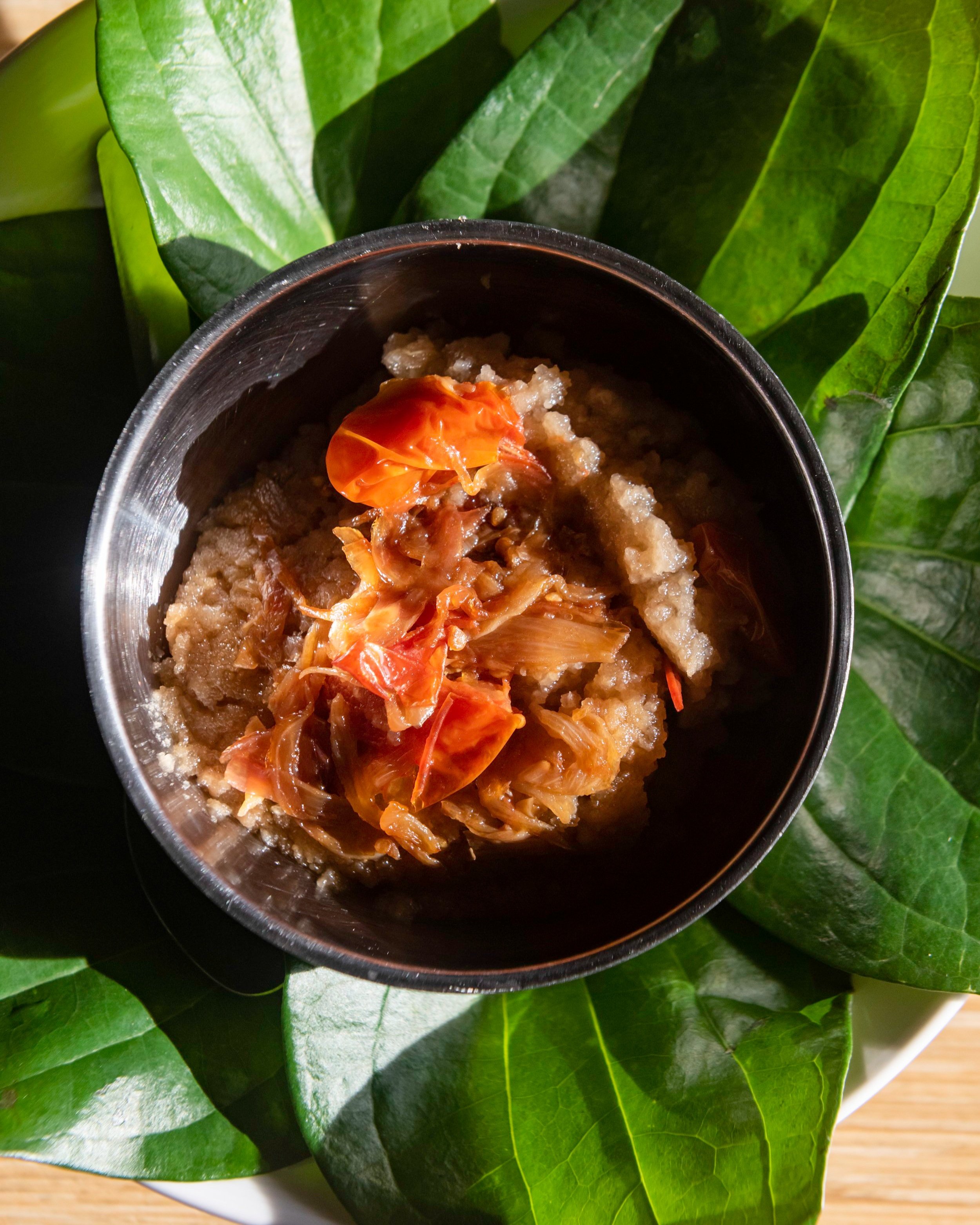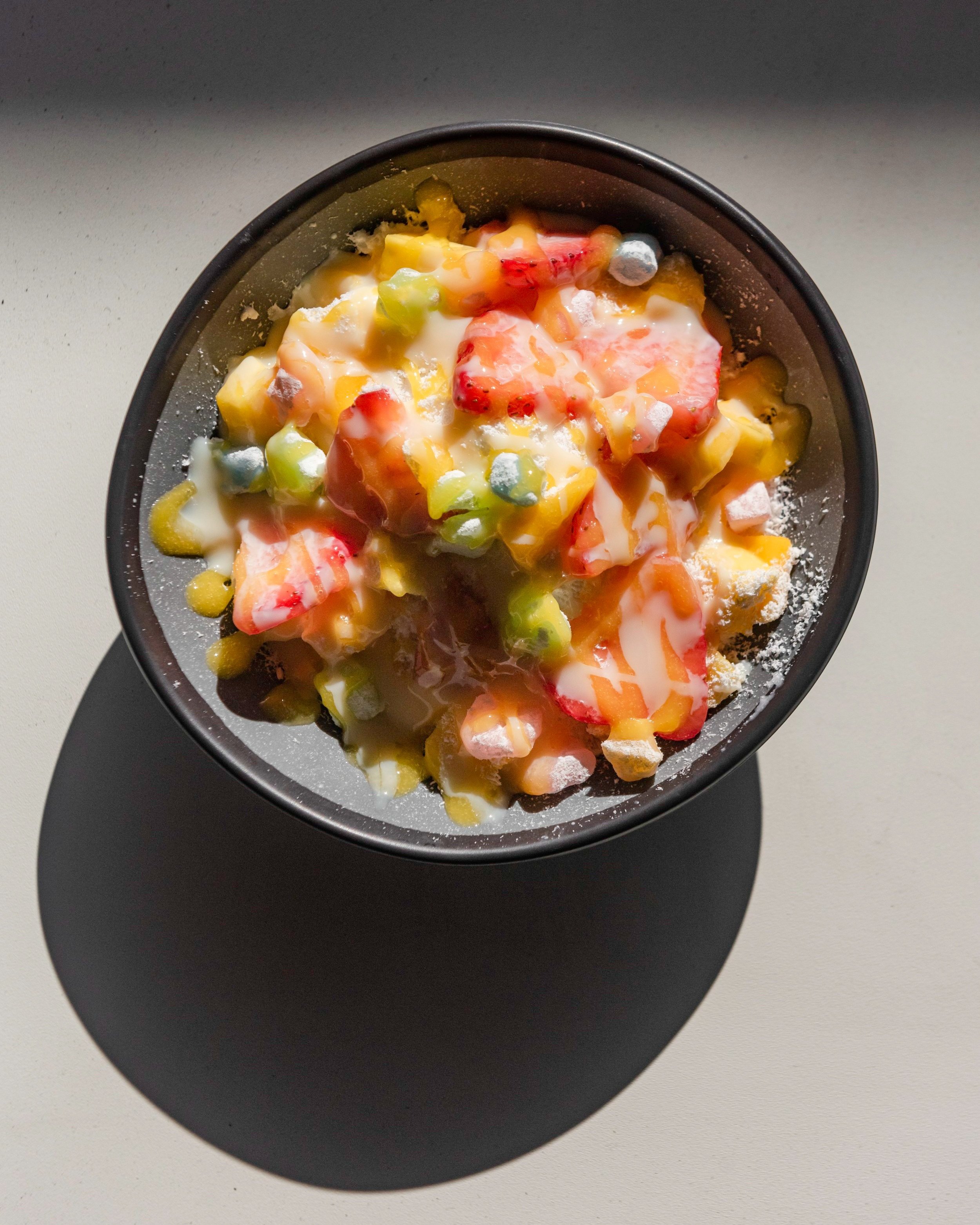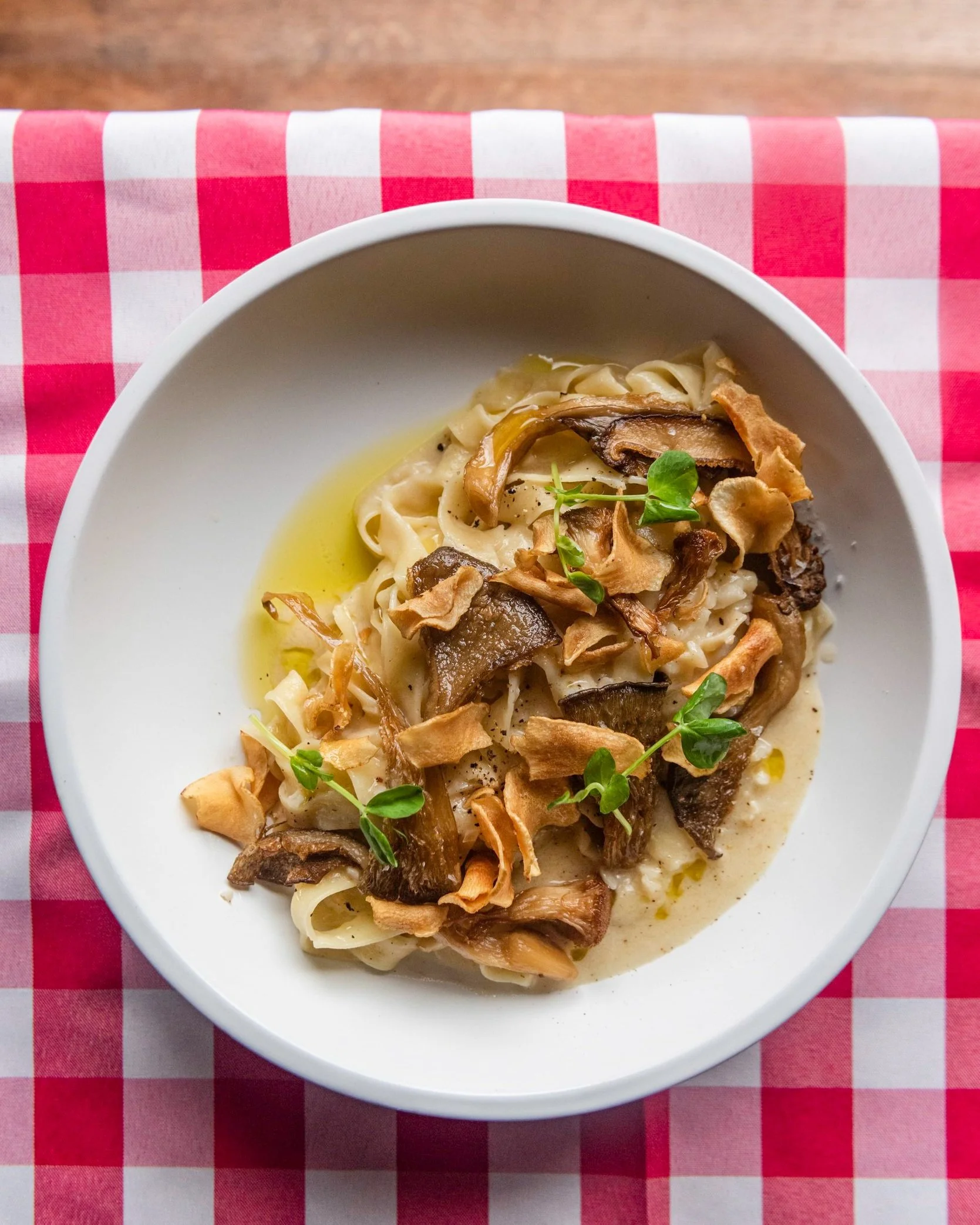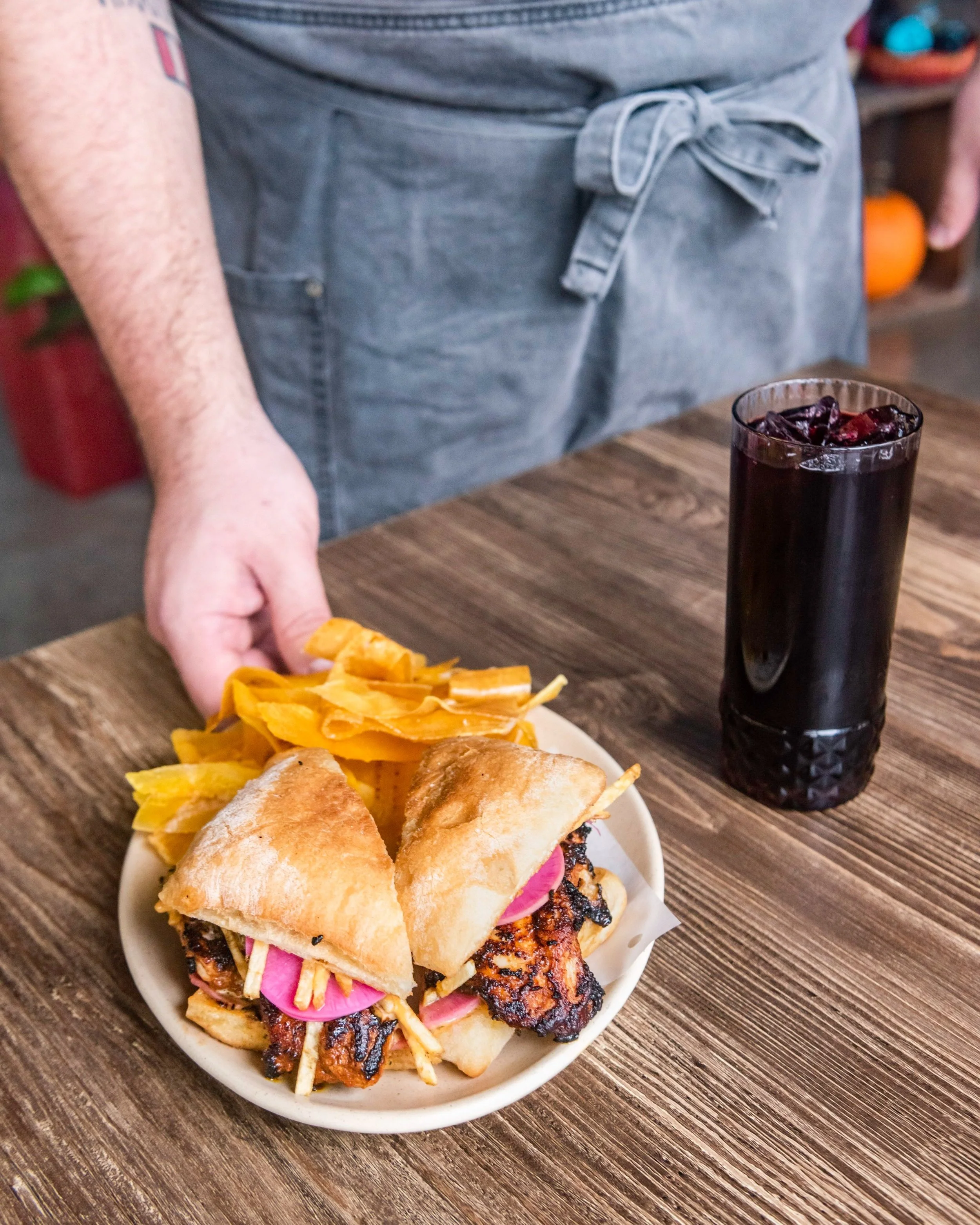2023 Atlanta Kitchen Notebook
An in-depth look at some of our favorite dishes and cocktails from our time on the ground in Atlanta.
Mieng Muang Luang
Chef Thip Athakhanh was on a camping trip with family when her sister-in-law served one of the most delicious meals she had ever tasted: Mieng Muang Luang, an umami-packed Laotian dish of sticky rice paste served alongside fresh condiments. Back in Atlanta, Athakhanh went on a deep dive into all things Mieng Muang Luang. “I started looking it up online and trying out everyone’s version.” The process starts with the rice powder, made from sticky rice that’s dried, fried, and pulverized. Next comes a simple broth that Athakhanh makes by cooking down a mixture of pork neck bones, ground pork, lemongrass, shallots, garlic, galangal, makrut lime leaves, fish sauce, and chicken powder. From there, she uses a mortar and pestle to slowly incorporate the hot broth into the rice powder until the mixture turns gooey and tacky. The dish is eaten as a wrap—Athakhanh likes hers with lemongrass, ginger, garlic, pork rinds, and cucumbers. For a twist, she also adds unripe green plantains for some nuttiness and caramelized tomatoes and shallots. The bitter, fresh greens complement the rich, sweet umami of the paste, making for an addicting, texturally complex bite. Although the time-intensive dish is not always on the menu at Snackboxe Bistro, Athakhanh makes it for her family often, carrying on the legacy of the meal. “It's an intimidating dish to make, so I want to document it and pass it along. It's loved by so many Lao people.”
Tepache Milk Punch
When Beverage Director Antonio Morales lived in Mexico City, he made a daily ritual of stopping by a street vendor’s stall and picking up fresh tepache, so it seemed natural for him to incorporate the fermented pineapple beverage into a cocktail at Palo Santo. “I’ve never seen any cocktails with tepache here, or in Mexico. The only tepache I could find in Atlanta was bottled, and it wasn't very good. So, I started making it myself.” To make his tepache, Morales starts off by thoroughly cleaning and removing the skins of two pineapples, fermenting them with the pineapple’s core, water, piloncillo sugar, cinnamon, clove, and allspice for three to seven days before straining it. Then, he lets it ferment even longer. “What's really cool is that the more it sits, the funkier it gets. I usually let it sit for a week.” For the base of his cocktail, Morales chose mezcal. “I’ve done half tequila and half mezcal, all mezcal, and other liquors. This [combination] is the most balanced and really showcases the tepache.” Morales also adds pineapple juice, lime juice, and pineapple rum to play off the fruitiness of the tepache and to balance out its sweetness. For extra depth and a touch of heat, he mixes up a spiced honey syrup with cloves and chiles de árbol. The drink is then clarified for a boozy cocktail that’s tangy and funky with a silky smooth mouthfeel. “It’s super drinkable and balanced,” says Morales. “I always keep a small stash at home.”
Coconut Shaved Ice
What’s the best cure for a hot summer day in San Juan, Puerto Rico? For Pastry Chef Carelys Vazquez of Lazy Betty, Juniper Cafe, and Humble Pie, it was indulging in piragua, the shaved ice dessert sweetened with fruit syrups. So when Chef Ron Hsu asked Vazquez to put shaved ice that reflected his Chinese heritage on the menu at Juniper Cafe, Vazquez knew it was on her to see how the different cultures could meet through their food. “Chef Ron wanted something that was so familiar to me, but done in a completely different way.” Vazquez starts with the ice block. She uses a technique that she picked up from Hsu, and mixes water with coconut milk, cow’s milk, sugar, and a coconut cream compound for a toasty and sweet coconut-forward base. It’s then molded and frozen to fit into the restaurant's ice shaver. “I love that even though it’s not traditional to Puerto Rican cuisine, it reminds me of home,” says Vazquez. “I love that relationship between chef and owner, to be able to have that teaching moment and to learn something new.” Served with fresh mango and strawberries, mango coulis, mochi balls for texture, and sweetened condensed milk, Vazquez’s coconut shaved ice is a symphony of temperature and tropical flavors, and is oh-so-craveable under the hot Georgia sun.
Spiny Lobster Salad
In Atlanta, as the leaves begin to change, two of the South’s finest exports overlap for a short time: the sugar-filled muscadine grape and succulent spiny lobster from the Gulf of Mexico. And for Chef Mykel Burkhart at Miller Union, who prepped a Concord grape and lobster dish while staging at Blue Hill at Stone Barns in 2018, the pairing seemed natural. “The fortified Concord grape sauce had all sorts of umami, but also this beautiful sweetness that complemented the lobster tail.” Burkhart begins by steaming Carolina Gold rice over lobster stock, infusing the aromatic rice with a deep shellfish flavor. He then lightly poaches small pieces of the spiny lobster tail, “so that you still have that super buttery texture on the inside.” He studs the lobster with finely diced celery, shallot, fennel, daikon, and puffed rice before spooning it over the tender steamed rice. Burkhart tops the salad with meticulously shingled, notoriously finicky muscadine grapes, which require “a very finely serrated knife, and patience.” Following Miller Union’s nose-to-tail, root-to-leaf philosophy, he seasons the dish with a mayo made with the lobster’s tomalley, as well as fennel oil made from the fronds. “It’s simple but decadent, and for us, represents the seasonality of Atlanta.”
Volcano Dog
It’s midnight, and Chef Lino Yi sits patiently waiting in his sushi truck outside of a dive bar in downtown Orlando. The punk show going on inside rages, while Yi twiddles his thumbs. Though he’s fully stocked and ready to serve freshly rolled sushi to the hoards of drunken bar goers, the crowd continues to stumble right past him. “Out of spite I was like, ‘You know what, these kids just want like…hot dogs.’” So, Yi popped into the corner store down the road, bought a couple packs of Nathan’s hot dogs and buns, and returned to the truck, guns blazing. He fired a couple dogs, and began topping them with all the classic volcano roll accouterments: tender sticks of imitation crab, tangy eel sauce, fresh scallions, and sesame seeds. To recreate the roll’s signature warm and saucy lava-like topping, Yi finished the dogs with a heavy dose of punchy sriracha, and torched the whole thing to add some smoky flair. One customer was all it took; a bleary-eyed punk rocker devoured the dog before hurrying back inside the bar to tell their friends. The Volcano Dog was born. Yi’s newly coined “fast-casual drunk food” was a hit, and now defines the menu at his brick-and-mortar in East Atlanta Village, TKO.
Sunchoke Alfredo
Step from the quiet streets of Atlanta’s Candler Park neighborhood into Gigi’s Italian Kitchen & Restaurant and you’re immediately transported to Little Italy; a land of red checkered tablecloths, a wooden bar laden with assorted tchotchkes, and candelabras dripping in wax that look like they have been burning since long before Chefs Jacob Armando and Eric Brooks were born. The immersive Italian mom-and-pop vibe extends to the menu, with dishes like fried polenta and “‘World Famous’ Tiramisu.” “The whole menu is riffs on classic shit, but not done in classic ways, using good products,” says Brooks. The fettuccini alfredo isn’t really “alfredo” at all, but a dish of fresh pasta in an earthy and creamy sunchoke sauce with seared locally grown mushrooms, parmesan, and crispy sunchoke chips. The dish is simple, but impactful. The sunchokes are cooked down with onion and herbs and blended with cream. The sauce is built to order with garlic and plenty of butter. A final squeeze of lemon balances the bite with a bright pop of acidity, rounding out a decadent pasta dish that’s slurpable, light, and full of flavor.
Pollo Anticuchero Sandwich
Growing up between Peru and Atlanta, eating sandwiches is one of Chef Arnaldo Castillo’s earliest food memories. Whether it was his father making pan con chicharron with sweet potatoes and salsa criolla on Sundays in Georgia, or the turkey sandwich from his godparents’ deli in Piura, Peru, Castillo knew that he wanted to pay tribute to Peruvian sandwich culture on his lunch menu at Tio Lucho’s. Castillo takes his sandwiches one step further by including anticuchos (another beloved Peruvian street food), which typically are grilled beef hearts that have been marinated in a mix of chiles, beer, and vinegar. Opting for a juicy grilled chicken thigh instead, Castillo spreads a tangy crema de ají on both sides of a griddled ciabatta roll, and pairs the flavorful chicken with bread and butter pickled daikon radishes, shoestring potato chips, and a side of plantain chips. “Normally, you don’t see pickles in Peruvian sandwiches,” says Castillo. “But my wife is from Georgia—she was like, ‘It needs acidity to bring it together,’ so we landed on pickling the daikon. The toppings are my take on combining my two worlds; an authentic Peruvian sandwich born in the South using regional ingredients.”













